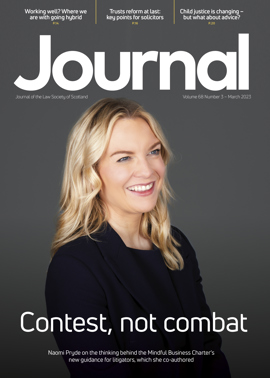Needs not deeds

The Children (Care and Justice) (Scotland) Bill was introduced into the Scottish Parliament in December 2022, following a consultation on its principles which took place last year.
Its provisions make changes to the way in which children are treated in both the care and criminal justice systems. As a consequence, the way in which the two systems interact is also impacted. The new measures are taken with the objective of ensuring children are treated in the most appropriate, trauma informed and rights respecting way when they come into conflict with the law and are in need of care and protection.
This interaction between the two systems is hugely important to get right, particularly for children and young people involved in offending behaviour. Since the Kilbrandon report was published in 1964, the welfare principle has been central to the way in which Scotland responds to children and young people in conflict with the law. The children’s hearing system (“CHS”) was established to remove children under 16 from adult criminal procedures, with the exception of extremely serious offences. Within the CHS there are a range of measures that can be used to ensure that children receive the right level of support. While our understanding of the drivers of offending behaviours in children and young people has come a long way since 1964, the core Kilbrandon principle that children involved in offending are in need of care and protection should be as relevant a policy objective today as it was 60 years ago.
The changes
This article focuses on three of the most significant changes the bill proposes to the CHS and considers whether they reflect its policy aim. However, before doing so there is also a broader issue to reflect on. The bill proposes incremental changes to how Scotland responds to children and young people in conflict with the law, but focuses primarily on the CHS and pays little attention to what happens where children and young people come into contact with the courts or the wider criminal justice system. It is questionable whether the adult criminal justice system can ever ensure a child centred, trauma informed environment, and the limited attention paid to it impacts the ability of the bill to achieve its policy aim. Thus, what is not in the bill is potentially as significant as what is in it.
There are also issues in relation to the extent of ministerial power. The bill grants framework powers to the Scottish ministers in relation to secure care and cross border placements, probably so that ongoing policy reviews can feed into ministers’ decision making at a later date. Nonetheless that has the potential to cede too much power to the Scottish Government in areas where there can be significant scope to impact rights.
1. UNCRC compliant age of child
The Bill is split into four parts. The first part includes one of the most significant changes to the current system, to bring the definition of “child” in line with the United Nations Convention on the Rights of the Child. To this end, the definition in the CHS increases from up to the age of 16, to under the age of 18. Access to supervision and guidance is also extended up to the age of 19. Prior to this change, young people aged 16 and 17 who have been arrested for offending behaviour, and are not already in the CHS, cannot be referred to the children’s reporter as an alternative to prosecution under the joint referral process.
For many children and young people this change will undoubtedly be positive; however, at the same time as placing more children within the CHS, part 1 increases the power of the children’s hearing to place limitations on the movement, and behaviour (in relation to a specified person or persons), of children referred to it. These restrictions can be used as a consequence of behaviour that would not meet a criminal standard in court. When you consider that children and young people in a children’s hearing are less likely to be offered legal representation than those appearing in court, this seems a significant risk to children’s rights. These orders may also impact their future prospects through disclosure requirements. It is Clan’s view that the expansion of automatic access to legal advice in children’s hearings is of such importance in the context of these changes that this needs to be reviewed as part of this bill and not deferred to the wider review of
the CHS.
2. Movement restriction conditions and the test for “harm”
Part 1 also extends the circumstances in which a movement restriction condition (“MRC”) can be imposed. At present it is aligned to the secure care criteria, as an option to be considered prior to a secure care order being made. As it has only been considered in this context, a child has access to automatic legal aid to instruct a lawyer and be offered a duty lawyer to consider the merits or otherwise of having their liberty restricted in this way. By uncoupling it from the secure care criteria, automatic legal aid and a duty lawyer may not be provided to advise the child or young person at a hearing where such an order is being considered unless secure accommodation is also being considered. Given its potential to significantly restrict a child’s liberty, this is of serious concern, requiring amendment to the legal aid regulations.
Prior to the bill, an MRC can only be imposed to protect a child and others from harm or where there is a risk to the child’s psychological, physical, mental or moral welfare. If those circumstances are met, a child can be prohibited from approaching, communicating with or attempting to approach or communicate with a named individual, or have their access to certain places restricted. As an alternative to secure care there also need to be measures put in place to support the child while out in the community.
The new test for an MRC focuses on two criteria: “that the child’s physical, mental or moral welfare is at risk”, or “that the child is likely to cause physical or psychological harm to another person”. The extension of harm in this context to include psychological harm is concerning. The definition section states that this includes “fear, alarm and distress”, but unlike in other areas of civil and criminal law there is no objective measure of what might constitute those elements of the test. There is therefore a risk that this could be interpreted widely and become a catch all for behaviour that may not have fallen under the test for MRCs previously.
Additionally, there is a risk that without supports to enable compliance with the restrictions, vulnerable children and young people will breach these orders. There is no clear guidance in the bill as to what the consequences might be, but there is a concern that a breach itself could result in an offence having been committed. In essence this net widening on low level behaviour could end up criminalising children and young people for behaviour that poses no risk to the public.
This definition has also been included in other remedies available to the children’s hearing, including in the secure care criteria: the test for ordering a medical examination on a child and to obtain a warrant to secure attendance at a children’s hearing. Again this represents a worrying uptariffing of children’s behaviour, and in none of these instances – bar applications for secure care orders – is there an obligation to provide legal advice or representation to the child or young person before these orders are granted.
3. Ban on children in young offenders’ institutions
Part 2 fulfils one of the Scottish Government’s commitments to the Independent Care Review, to stop the imprisonment of children and young people. The bill makes provision that children under 18 will no longer be able to be placed in young offenders’ institutions. Where they have to be detained this will happen in a secure care setting where they will have access to support. The bill also makes it clear that all children and young people who are detained in secure care will be considered to be “looked after” and entitled to access aftercare on their release. This is a significant and important commitment that will improve outcomes for children who have been convicted of an offence.
Concluding remarks
Overall, there are positive changes in the bill in relation to achieving a child focused, rights respecting justice system for children in line with Kilbrandon principles. It contributes to a harmonisation of the definition of child in Scottish legislation in line with the UNCRC, and bans the practice of imprisoning children – which is a huge step forward.
However, the bill does nothing to improve access to legal advice in the CHS. This is despite proposals to increase the scope of the powers open to the children’s hearing to restrict the liberty of children. This is a missed opportunity and critical in protecting children’s rights. The proposed changes mean that not only are children being asked to agree offence grounds without automatic legal aid to obtain the advice of a solicitor or a duty solicitor being appointed, they may now face having their liberty restricted through the imposition of an MRC without these fundamental entitlements.
While some will justify this approach on the basis that the child is not being prosecuted and will not have a criminal record, as current disclosure rules stand these matters can be revealed when the child is an adult through the “other relevant information” criterion on PVG checks. In our view this is a significant omission that tracks through the bill in all of the proposals that relate to the CHS, and it should not wait for the outcome of a wider policy review before being rectified.
Perspectives
Features
Briefings
- Civil court: No rule against redaction
- Corporate: Privileged or confidential – who can access
- Intellectual property: Big tech, AI and enforcement
- Succession: Non face-to-face will instructions; form C1
- Agriculture: “Route map” for agricultural reform
- Parking: About this ticket…
- In-house: Caring for the carers







